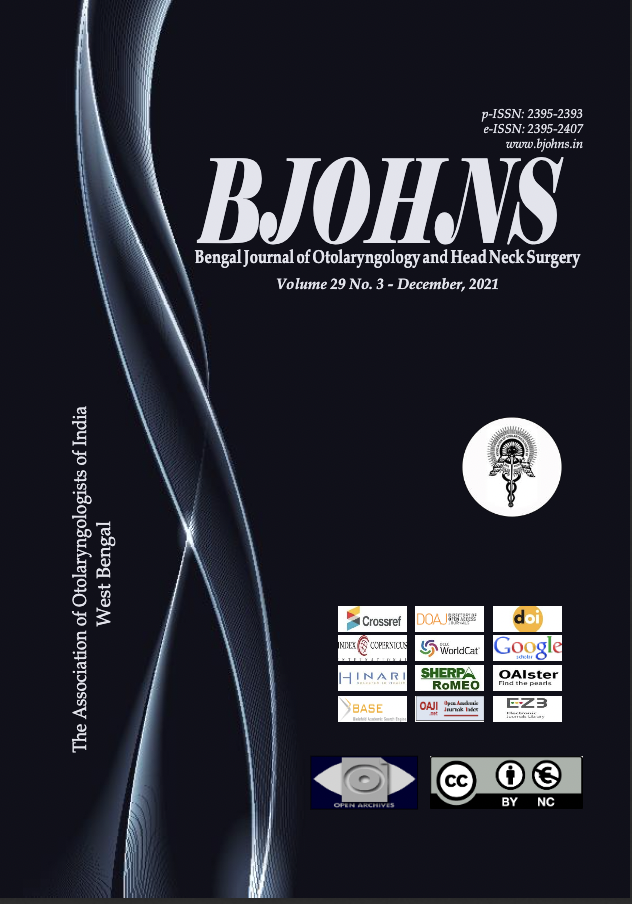Assessment of Variations in Sphenoid Sinus Pneumatization in South Indian Population
Main Article Content
Abstract
Introduction
Morphometric study of sphenoid sinus shows various degrees of pneumatization. Knowledge of such variability is extremely important to guide the surgeon in predicting what type of surgical approach will be safer for the pathologies involving skull base region. Considering recent advances in trans-nasal trans-sphenoidal endoscopic interventions and improved visualization, it has become imperative to become familiar with the anatomical variations which are likely to be encountered during surgical procedures.
Materials and Methods
A retrospective study was conducted on the basis of CT scan records of 120 patients to evaluate variability in pneumatization of sphenoid bone and its extensions in South Indian population.
Results
The study revealed the prevalence of conchal, pre-sellar, incomplete sellar and complete sellar types of sphenoid pneumatization in 02%, 08%, 28% and 62% cases respectively. Posterior or clival extension was the commonest type seen in 80% cases which included sub-dorsal (50%), dorsal(15%) and occipital(15%) types of clival variants. In lateral extensions, pterygoid sub-type was observed in 37% of patients whereas lesser wing, greater wing and full lateral sub-types were present in 20%, 14% and 09% cases respectively. Various combinations of lateral sub-types were seen in 15% of study population.
Conclusion
In our study higher percentage of pneumatization of sphenoid sinus and its extensions was observed when compared to Egyptian and Chinese populations. High prevalence in South Indian population also provides an additional armament in the hands of surgeon to reach the otherwise unreachable lesions involving middle and posterior cranial fossae through trans-sphenoidal approach.
Article Details

This work is licensed under a Creative Commons Attribution-NonCommercial 4.0 International License.
References
Hiremath SB, Gautam AA, Sheeja K and Benjamin G. Assessment of variations in sphenoid sinus pneumatization in Indian population: A multidetector computed tomography study. Indian J Radiol Imaging 2018;28(3):273-9. doi:10.4103/ijri.IJRI_70_18
BaldeaV, Sandu OE. CT study of the sphenoid sinus pneumatization types. Romanian Journal Rhinology 2012; 2(5):17-30
Wang J, Bidari S, Inoue K, Yang H, Rhoton A Jr. Extensions of sphenoid sinus. Neurosurgery 2010; 66(4): 797-816. doi: 10.1227/01.NEU.0000367619.24800.B1
Kusch AM and Garcia VR. Giant pneumatization of sphenoid sinus: Report of four cases and review of literature. Rev Med Hered 2019; 30:45-9. doi: 10.20453/rmh.v30i1.3472
ELKammash TH, Moans M Enaba, Akram M Awadalla. Variability in sphenoid sinus pneumatization and its impact upon reduction of complications following sellar region surgeries. Egyptian J Radiol and Nuclear Med. 2014; 45: 705-14.
doi:10.1016/j.ejrnm.2014.04.020
Sevinc O, Is M, Barut C, Erdogan A. Anatomical variations of sphenoid sinus pneumatization in a sample of Turkish population: MRI study.Int J Morphol. 2014; 32(4):1140-3. doi: 10.4067/S0717-95022014000400003
Hamid O, Fiky LE, Hassan O, Kotb A, Fiky SE. Anatomical variations of the sphenoid sinus and their impact on trans-sphenoid pituitary surgery. Skull Base 2008; 18: 9-16. doi: 10.1055/s-2007-992764
Zada G, Agarwalla PK, Mukundan S J, Dun I, Golby AJ, Laws ER. The neurosurgical anatomy of the sphenoidal sinus and sellar floor in the endoscopic transsphenoidal surgery. J Neurosurg. 2011; 114(5):1319-30. doi:10.3171/2010.11.JNS10768
Craiu C, Sandulescu M, Rusu MC. Variations of sphenoid pneumatization: a CBCT study. Romanian J Rhinol. 2015; 5(18): 107-13.doi:10.1515/rjr-2015-0013
LuY, Pan J, Qi S, Shi J, Zhang X, Wu K. Pneumatization of the sphenoid sinus in Chinese: The differences from Caucasian and its application in the extended transsphenoidal approach. J Anat. 2011; 219:132-42. doi:10.1111/j.1469-7580.2011.01380.x.

